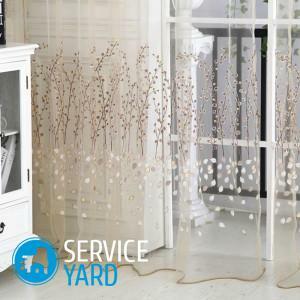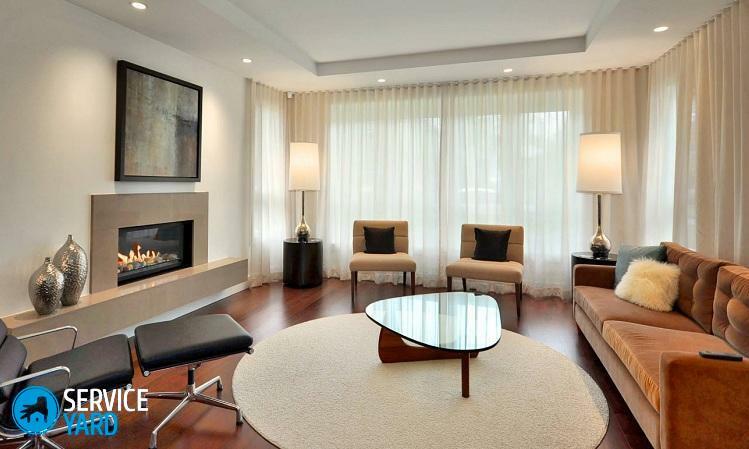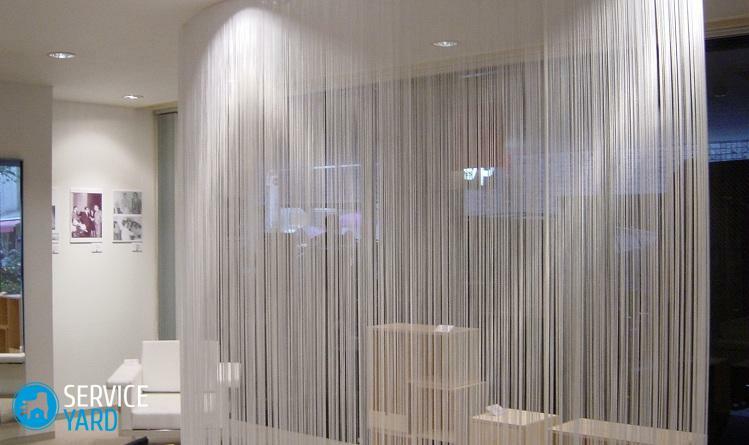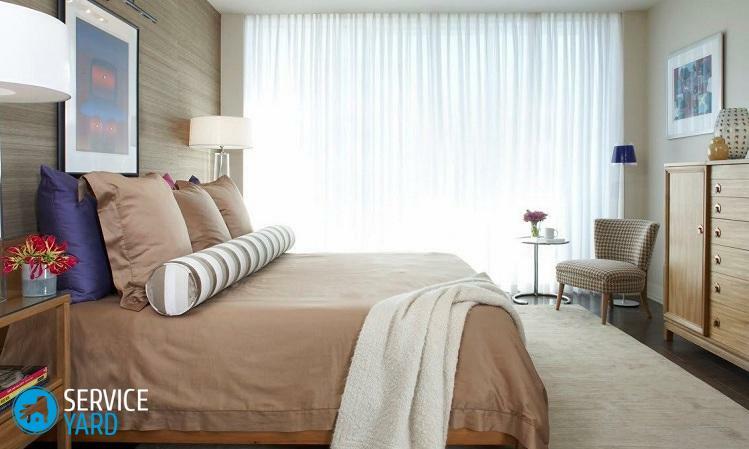
- Cornice - an important basis for tulle
- Methods for fixing curtains to the cornice
- Secrets of beautiful drapery
In the design of interiors, a special and important role is played by textile design - a separate place in which housing is provided for curtains. A lot of popularity in this case uses a variety of curtains, like tulle. Elegant and airy - he will certainly decorate any room. Beautiful folds of the curtains create a special comfort in the room, give it a warm, finished look, because without textiles the interior looks faceless, uninteresting. But in how to hang tulle, there are special features and nuances that must be taken into account if you want to achieve a stylish, elegant drapery.
to content ↑Cornice - an important basis for tulle
Window decoration with thin tulle begins, first of all, with the selection of the eaves, to which it will be suspended. This device is designed to retain curtains, but in addition to this task, it also performs an aesthetic function. Products are presented in a wide range, so the right choice will be the key to the future success of the entire textile composition.
Types of eaves for curtains by the number of curtains
How to hang tulle on the cornice - depends largely on its variety. At the moment, we can distinguish such types of products:
- Single-row. This type of products provides for the installation of only one curtain. If you decide that your window will decorate only the tulle, you can stop choosing on such a cornice.
- Multi-row. Such a system of cornices provides for two or more rows of curtains.
Important! If, in addition to tulle, you plan to hang tight curtains to create a pleasant semi-darkness in the room, then it is the multi-row type of device that will fit.
Form and device
Based on the configuration, the cornices are divided into the following types:
- String. It is a thin stretched cable between two fasteners. You can stretch a string in several rows. Tulle to such a cornice is usually fastened by means of clips or hooks. Such products can be easily mounted both to the ceiling and to the wall. And the advantages of the cornice are low price, versatility, compactness.
Important! This type of product is designed for light materials. The strings can not withstand the heavy curtains - in time they will start to sag.
- Framed. The cornice can be attached to a wall or ceiling, but it is the basis for the fastening of the tulle hidden behind the original decorative strip. Better still, this type of product looks at the ceiling installation, because elegant folds flow straight from under the luxurious baguette from the ceiling to the floor.
Important! This version of the cornice is especially suitable for rooms with high ceilings. And it also carries a separate stylistic load in the interior.
- Profile. This type of cornice is more durable. Due to the aluminum base, it is able to withstand several rows of curtains, including heavy curtains. The cornice is made in the form of several guides. You can install it anywhere: on the wall, ceiling, window frame or directly in the opening. In addition, this product is available for the design of designs of any shape.
Important! The profile cornice can be equipped with a remote control system. This is especially true for windows that are located high, and it is not possible to manually adjust the curtains.
- Tubular. This version is a bar, fixed on special brackets. The appearance of the product is classical and harmoniously combined with almost any interior. How to hang a tulle on a round cornice? To do this you will need rings or eyelets.
- Tire bus. This type of cornice is a plastic base, in which there are recesses in the form of paths along which the hooks move. And already directly attached to them is tulle. The product can be single-row and multi-row. Tire cornice often has a ceiling type - thanks to this setting, there is no distance between the ceiling and the curtains. This effect visually makes the room higher. But there are also wall cornices, for which special brackets are required.
Important! This type of cornices has some limitations in the load, so it is not suitable for heavy, bulky drapes.

How to attach
If you decide how to hang a tulle by the method of fastening, here you can distinguish two main types of products:
- Ceiling. This version of the installation of the cornice has a number of advantages. First of all, they highlight the simplicity, availability, versatility of this product. Cornice is suitable for rooms of any size, the type of curtains, can have different shapes, which is very convenient for decorating in the interior or other curved design designs. Plus, the ceiling type saves room space.
Important! The only exception for using this type of product is a tension or suspended ceiling. To install the ceiling cornice is possible only at the stage of installation of such a coating.
- Wall mounted. This type of cornices is easily mounted to the wall plane, it also has a wide range of varieties, product shapes. The classic version fits perfectly into the interiors of various stylistic directions.
Important! Wall cornices can have a complex system of construction and be equipped with a lifting mechanism, which adds to their ease of use.
Materials in the base
Ceiling structures withstand greater weight than wall types of cornices.
Cornices are classified according to the material from which they are made:
- Wooden.
- Plastic.
- Forged.
- Metallic.
In order to choose the right option, take into account the style of the interior of the room. Let's admit:
- A laconic string or a metal product is definitely suitable for the direction of High-tech or Minimalism.
- A massive wooden cornice is an excellent addition to a country-style room, which, by the way, is perfectly suited forged products.
- Classic style is best emphasized with a molding cornice.
- For magnificent directions of Baroque, Empire or French style, choose forged products with expensive gilding, exquisite carving. Models should be pretentious, but necessarily elegant.
How to choose the right cornice?
The aim of this article is to teach you not only to correctly hang curtains and tulle, but also how to choose the best cornice for these purposes. The choice of this or that product is influenced by a number of such factors:
- Dimensions of the cornice. For modest and small rooms, you should not choose massive and cumbersome designs, but it is best to do with simple and concise solutions.
- Load on the cornice. Depending on the material of the curtains and their number, a suitable type of product capable of withstanding a certain load will vary.
Important! For tulle, any option is suitable, since the fabric is light and weightless.
- Fastening of curtains. Also an important nuance in the selection of the cornice, which depends on the fabric of the curtains.
- The size and shape of the window on which the cornice is mounted. For non-standard forms it is better to provide installation of flexible structures.
- The size of the window sill and the presence of other elements. To the tulle does not touch the sill and did not cling to it, consider its parameters when selecting and installing the cornice. As a result of the miscalculations, the result obtained can have a negative effect, and instead of a light streaming canvas you will get an unsightly curtain, which is pricked. In addition to the windowsill, pay attention to the location of the battery, heating pipes and the presence of a door to the balcony.
- Visual effect. If using tulle you want to adjust the spatial perception of the room, then the cornice must be selected, based on the desired result. So, visually to make a room above the ceiling type of a product will help. By means of the ledge, which extends far beyond the boundaries of the window opening to the plane of the walls, a narrow window can be made wider.
Methods for fixing curtains to the cornice
One of the important nuances of the design of curtains is the determination of the way the curtains are attached to the cornice. Next, we'll look at how to hang tulles on hooks or rings, eyelets or loops, and also what are the features of each of these options.
The choice in favor of one of the types of fittings depends, first of all, on:
- Type of cornice.
- Room styles.
- Compositions of curtains and their material.
Let's move on to a more detailed study of fasteners.
Kulisk
Perhaps this method of fastening the tulle to the cornice is the simplest. The kulisk is a tunnel through which the product passes. It is very easy to make a kulis: bend the upper edge of the tulle and sew on the machine. No more hardware and parts are required. Remove the curtain, too, will not be difficult - just pull it off the pipe.
Important! The size of the kulis must correspond to the diameter of the cornice.
The only drawback of this fastening is the difficult adjustment of the tulle along the cornice.

Eyelets
This type of accessories for curtains has come into vogue quite recently and has already fallen in love with many designers. How to hang tulle on such adaptations?
Eyelets are metal rings that are located in the holes of the upper part of the curtain. They are placed symmetrically in its entire length. Later, through these rings, the curtain is threaded onto the cornice.
Pros of this fastening:
- Stylish and original appearance.
- Profitably emphasizes the beauty of curtain material.
- Eyelets allow you to create elegant and even folds.
- Curtains are easy to move around the cornice.
- Versatility of fasteners. Eyelets are great for any type of room - from the nursery to the kitchen, and are in harmony with any style of the interior.
But there are some drawbacks to this method of fixing curtains:
- The tangible cost of the elements, their complexity of mounting on the fabric.
- It is better not to use eyelets for light, thin materials.
- Noise when adjusting curtains from metal rings.
Important! For tulle, the eyelets are not the best mounting option, since heavy elements can damage the delicate material. But if the desire to use such a system is great, then the problem can be solved in such a way: the upper part of the fabric can be strengthened by means of a dense tape under the color of the curtain.
Rings
These parts used for attaching curtains are very simple and easy. Most often, the rings are metal or wooden. From the eyelets they are distinguished by their location: the rings are not on the fabric, but separately. To fix the tulle to the rings will require additional hardware.
Important! Rings are suitable for round-shaped cornices and dress directly on the bar.
How to hang a tulle on a round cornice with rings? There are three options:
- Sew the tulle directly to the rings.
- Use curtain braid and hooks.
- Hooks. This method is used most often. How to hang tulles on hooks? One end of the part is sewn to the material of the curtains, and the second is fixed on the ring. Advantages of fittings in the form of rings:
- Aesthetic appearance. An important role is played by the color of the details, their design, which should correspond to the tone and style of curtains, cornices and the interior in general.
- Easy tulle travel along the cornice. True, there is a slight noise.
- Strength and wear resistance.
- Beautiful drapery of the canvas.
- Possibility of self-tailoring.
Clamps
Convenient clothespins or clips give the housewife the perfect opportunity to quickly and easily remove the curtains for washing and cleaning.
Important! All kinds of clips are suitable only for lightweight fabrics, since they can not hold dense curtains.
Advantages of the accessories:
- You can form excellent creases on the canvas.
- Clamps will not be able to tear the delicate fabric, do not stretch it.
- Versatile mounting.
- Ease of operation.
- Interesting decorative features.
The minuses can be attributed to a small noise that occurs when the curtains move along the cornice.

Hinges
These are fabric elements sewn over the top of the tulle. They are produced most often from the same material, but you can use the original braid or tape. The sizes of loops can be various - from imperceptible to rather large, which purpose is additional decor.
How to hang a tulle on the cornice for the hinges? The details are sewn on both edges to the curtain, and then put on the product through the received holes.
Advantages of such fastening:
- You can make it yourself. If you do not take it for yourself, sewing such loops will not be too expensive.
- Create an extra cosiness.
- Suitable for any type of cornice.
But there are a couple of drawbacks to such fasteners:
- If the hinges are long enough, a significant clearance is formed between the curtain and the cornice.
- Sometimes it is uncomfortable to adjust the tulle, as the fabric does not slip over the cornice.
Important! If you sew to Velcro fasteners, then you can quickly and easily remove the tulle.
Curtain tape
If you do not know how to collect beautiful tulle, then the simplest and most popular method is the use of curtain tape. What it is? A strip of material on which the entire length of the loop and cord. The loops can be arranged in one or two rows.
Principle of use:
- Curtain tape is fixed on the top edge of the curtain.
- Tighten the cord, thus forming beautiful folds.
- Suspend to the ledge by hooks.
Advantages of this braid:
- The tape can be used for any kind of cornice.
- Suitable for both light and heavy fabrics.
Important! For thin and delicate materials, a transparent curtain belt is used, and for heavy fabrics, a stronger and denser tape is used.
- Affordable price.
- Simple installation - you can handle on your own.
- Long service life.
Important! You can draw a short conclusion about how to properly hang curtains and tulle: for light and airy fabric, hooks, clips and curtain tape are best suited. But eyelets and heavy metal rings are not the best way to fix.
to the table of contents ↑Secrets of the beautiful drapery
After you have chosen the right cornice and how to attach the curtains to it, we proceed to decorating the window with exquisite canvases. In this creative process, several tips and recommendations will help you.
How nice to hang a tulle in the hall?
As in this room we meet guests and it is the "face" of the dwelling, then for its decoration you need to use beautiful and original compositions. The choice of this or that cornice is based on the style of the interior and the size of the room. If the interior allows, then you can choose products of artsy design, and drapery make it difficult and multilayered.
Important! When choosing the material in the living room, pay attention to the tulle with a pleasant overflow and shiny elements - this effect will give the room a special chic and gloss.
How nice to hang a tulle in a bedroom?
For this room are appropriate compositions of several rows of curtains and tulle. Therefore, you need a multi-row cornice, but by the method of installation it is better to choose a ceiling type. Create effective creases can be using curtain braid and hooks.
How nice to hang a tulle in the kitchen?
The optimum choice for the conditions of this room is the rod cornice. Such a product is easy to clean and wash, and that the tulle can be washed more often, use clamps. With their help you not only can easily and quickly remove the curtains, but also create an elegant drapery.
The length of the curtains in the kitchen reaches the sill. A curtain can be hung on the floor only if the room is very spacious and allows you to embody this design, without damaging the delicate fabric. Another convenient mounting option may be a hinge, since then it will not be necessary to wash the fasteners from kitchen stains.

Tips & Tricks:
- Try to experiment and decorate the interior with curtains of different shades. This design move can be implemented in two variations: the use of contrasting tones or the use of a related color scale. For example, blue and blue.
- Wraps are formed in three ways: one-way, counter or bow. In the first case, the fabric is folded in one direction, in the second - adjacent folds are directed towards each other, and the third option is the wrong side of the second.
- Asymmetry is a bold decision that will attract the enthusiastic views of guests. Let the tulle descend beautiful folds and close the window. Portiera leave only one, fixing it with picks to the left and to the right of the opening.
- Look for interesting tulle species. The natural material of flax is perfect for premises in the style of Provence or Country. This fabric is slightly rude, but environmentally friendly. It is interesting to see tulle with various inserts - mesh, metallized or with colored patterns.
- For a classic interior choose a monophonic fabric that is close in color to the curtains, but its shade should be lighter by several tones.
- To create lush and beautiful folds, the length of the tulle should be twice the size of the cornice.
- Do not forget about the decorative fittings for curtains. This - various types of clips and pick-ups, cords and ribbons, elegant lace and spectacular flowers, beads, beads and bugles.
Important! Any elements should be in harmony with the overall design, do not be alabatic. The essence of this decor in the original strokes and stylish accents.
- Depending on the space of the room, it is necessary to take into account the intensity of the drapery and its complexity. So, in a modest room, the abundance of folds, lambrequins, complex fittings and an ornate cornice will create a clutter effect. Laconic and simple tulle folds will give the room lightness and spaciousness.
Tulle is a soft and light fabric that can transform any interior. Its use does not cease to be popular among designers and housewives. Having studied the article, you now know exactly how beautiful it is to collect tulle. There are a lot of methods for attaching curtains, from which you can choose the most optimal and effective. The main thing is that tulle should be practical and functional in operation. Well, undoubtedly, in harmony with the interior of the room.



